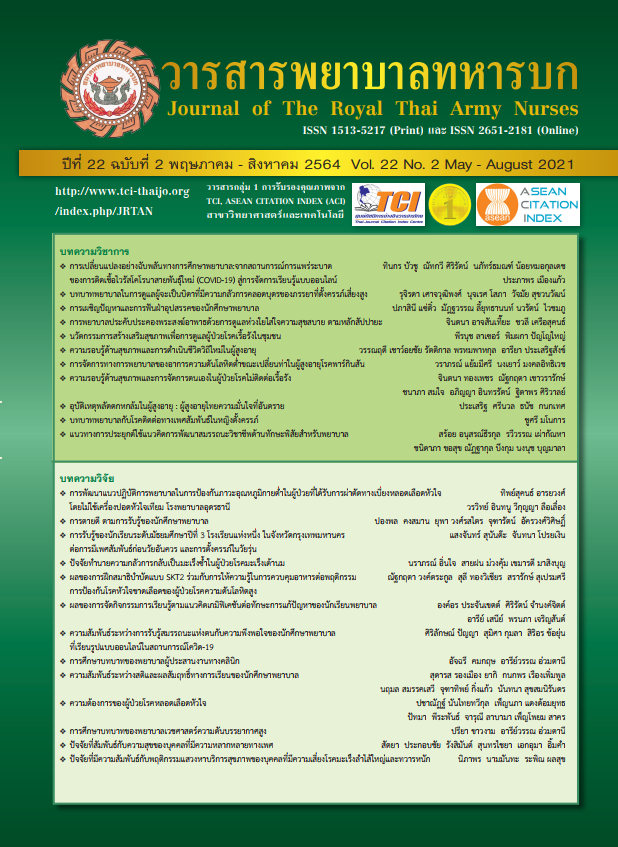Comparative Studies of Types of Nutritional Education Media, Consumption Behavior and Nutritional Status in Undergraduate Students and Employees of Chaiyaphum Rajabhat University
Keywords:
relationship study, media channels, consumption behavior, nutritional status, Chaiyaphum Rajabhat UniversityAbstract
From a study of 215 students and employee of Chaiyaphum Rajabhat University, the highest channel to receive nutrition education media was the Internet, accounting for 31.2 percent, followed by television, public relations boards, newspapers, magazines, brochures, radio, personal media and other media. The students had a normal weight of 66.2 percent, followed by being overweight, thin and very thin, 16.2%, 13.2%, and 4.4% respectively, while the staff members had a normal weight of 81.5 percent, followed by those who were overweight, very thin and thin, 7.4,% 7.4% and 3.7% respectively. The media that is most popular among males is television, accounting for 35.4 percent, while the most popular media for female is public relations boards with mean of media channels received between males was significantly different from that of females (p < .01). Among students the ages range of 18-19 years was significantly different from the age range of 22-23 years. However, the median channels received between the personnel of each age group were not significantly different from each other. In addition, the channels of nutrition education media with the level of health literacy and the nutritional status score no relationship by Pearson’s coefficient was at the .000 (p < .01), however only a slightly positive correlation was found in the health literacy level with the nutritional status score by Pearson’s coefficient was at .326 (p < .01), with the highest health literacy score among the samples who consumed the signboard media. 32.35 percent followed by television, internet, brochures, magazines, individual media, newspapers and community radio, which were 26.47, 24.51, 6.37, 3.43, .49 and .49, respectively.
Downloads
References
Aekplakorn W, Kessomboon P, Sangthong R, Chariyalertsak S, Putwatana P, Inthawong R, Taneepanichskul S. Urban and rural variation in clustering of metabolic syndrome components in the Thai population: results from the fourth National Health Examination Survey 2009. BMC Public Health. 2011; 11(1): 1-9.
Alberti K. GM M, Eckel RH, Grundy SM, Zimmet PZ, Cleeman JI, Donato KA, Smith JrSC. Harmonizing the metabolic syndrome: a joint interim statement of the international diabetes federation task force on epidemiology and prevention; national heart, lung, and blood institute; American heart association; world heart federation; international atherosclerosis society; and international association for the study of obesity. Circulation. 2009; 120(16): 1640-1645.
Heng D, Ma S, Lee JJ, Tai BC, Mak KH, Hughes K, Tai ES. Modification of the NCEP ATP III definitions of the metabolic syndrome for use in Asians identifies individuals at risk of ischemic heart disease. Atherosclerosis. 2006; 186(2): 367-373.
Charoensettasilp S, & Wu C. Thai Consumers” Satisfaction after Receiving Services from Thailand’s. Applied Mechanics and Materials. 2014; 505: 767-777. (in Thai)
Matsuda-Inoguchi N, Shimbo S, Zhang ZW, Srianujata S, Banjong O, Chitchumroonchokchai C, et al. Nutrient intake of working women in Bangkok, Thailand, as studied by food duplicate method. European journal of clinical nutrition. 2000; 54(3): 187. (in Thai)
Gupta S, & Gaur S. Lifestyle Patterns, Eating Practices and Obesity among Nurses: A Review. International Journal of Health Sciences and Research. 2016; 6(11): 258-266.
Musikthong J, Sriyuktasuth A, Kongkar R, & Sangwichaipat N. Nutritional knowledge, attitude towards food, food consumption behavior, and nutritional status in nursing students, faculty of nursing, Mahidol University. Journal of Nursing Science. 2010; 28(3): 40-49. (in Thai)
Sawilowsky SS. New effect size rules of thumb. Journal of Modern Applied Statistical Methods. 2009; 8(2): 26.
Institute of Nutrition. Database on INMUCAL Nutrients V.3. Nakonpathom; Institute of Nutrition Mahidol University; 2007.
Buddhapanyo S, Toontam N, & Pattanachot N. Effectiveness of Health Promotion Program, Health Literacy and Weight Control in Overweight Employees of Roi-ed Hospital, Muang, Roi-ed Province. Journal of Nursing and Education. 2016; 9(4): 42-59. (in Thai)
Indhraratana A. Health literacy of Health Professionals. Journal of The Royal Thai Army Nurses. 2014; 15(3): 174-178. (in Thai)
Teachavijitjaru S. Health literacy: Key to health behavior and good health outcomes. Journal of The Royal Thai Army Nurses. 2018; 19 (Suppl.1): 1-11. (in Thai)
Downloads
Published
How to Cite
Issue
Section
License
บทความหรือข้อคิดเห็นใดใดที่ปรากฏในวารสารพยาบาลทหารบกเป็นวรรณกรรมของผู้เขียน ซึ่งบรรณาธิการหรือสมาคมพยาบาลทหารบก ไม่จำเป็นต้องเห็นด้วย
บทความที่ได้รับการตีพิมพ์เป็นลิขสิทธิ์ของวารสารพยาบาลทหารบก
The ideas and opinions expressed in the Journal of The Royal Thai Army Nurses are those of the authors and not necessarily those
of the editor or Royal Thai Army Nurses Association.






